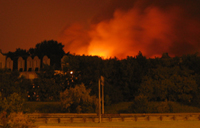In the event of a major disaster, disaster response personnel must rely on two-dimensional maps and Google Map data to determine their plan of action. But what happens when those maps are out of date or not matched?
An innovative project underway at York University involving the Faculty of Science & Engineering, the Faculty of Graduate Studies, and the Faculty of Liberal Arts & Professional Studies, is redrawing the map for emergency personnel. The project, which is funded by York University’s Academic Innovation Fund (AIF), brings engineers and students from the Geomatics Engineering Program together with scientists and students in the Graduate Program in Disaster & Emergency Management, to work on a new 3-D map system that incorporates a wealth of data from different resources into one seamless 3-D geospatial interface that will improve decision making in the event of an emergency.
The project team is using the York Keele campus as its “living laboratory”. Using aerial images and lidar data, blueprints, survey data and site visits, the group is working on constructing a detailed 3-D map of every road and building (both inside and outside) on the 650-acre campus.
The project, “The Geoinformation-based Disaster & Emergency Management Training Facility” is led by AIF project champions Costas Armenakis, professor of Geomatics Engineering, and Niru Nirupama, professor of Disaster & Emergency Management. The duo is leading the interdisciplinary team of students.
“The purpose of this project is to integrate maps with decision making approaches from the disaster and emergency management group,” says Armenakis. In essence, he says, the geomatics group is providing expertise into how to handle geospatial information and technology within the context of decision making in disaster and emergency management.

The technology, which makes use of geographic information systems (GIS), remote sensing and location data from global positioning system (GPS), is creating not only a map, but simulations of disaster scenarios that can play a preventative role in emergency management by identifying potential hazards.
“From the emergency management perspective, we look at identifying potential risks and hazards on campus. We look at what are the risks and where are they located, and if there are any associated hazards, such as chemical storage, which is important information that is required for future planning and risk reduction.” says Nirupama.
“I wanted the students in the Disaster and Emergency Management Program to come out of their comfort zone and explore the technical side and tools that are available in this day and age. The City of Toronto uses GIS for their emergency management process and this project gives our students important experiential education in that regard,” says Nirupama.
The test area is focused on the Keele campus because Armenakis says the Geomatics Engineering Program has developed a comprehensive collection of images of the campus, roads, locations for parking and building information.
“This technology provides a special view of the infrastructure so that in the case of an emergency at a building or a number of buildings we know where to direct people so that they can safely evacuate the building,” says Armenakis. “In order to do to know what the preferable evacuation route to this point is, the information provides the distance, where a safe point is and how long it will take people to get to the meeting place.”
In the case of a gas leak in the Chemistry Building, the GIS data could indicate that a chemical storage room could be a hazard to evacuating occupants through their usual point of exit. Armed with the information about what is contained in the building and its configuration, disaster and emergency management personnel could then direct those being evacuated to an alternate exit to avoid the potential hazard. They would be able to convey exact directions, location of the exit and how long it would take to get to safety to those being evacuated.
The system will also provide planners with a dynamic series of simulations and scenarios, which address what Armenakis and Nirupama call the “If” scenario. The information from the simulations when coupled with potential risk information could be conveyed to Emergency Management Personnel so that they can get prepared.
“Essentially we are developing a special GIS decision making system for emergency response,” says Armenakis. “The advantage to our students is that they see the actual geospatial information in a simulated experience.”
The system differs from Google Maps in that it provides dynamic simulations of scenarios. “If something happened on campus, say at a chemistry lab, our project is developing building evacuation scenarios. Google gives infrastructure, including some specific spacial route finding, but at the present time, Google does not provide any simulations,” says Armenakis.
“In the case of the 9/11 attack on the World Trade Center, many people did not know that certain stairways were available, or they did not know where to go and emergency personnel had limited information,” says Nirupama. Cellphone conversations from the tragedy reveal the lack of information that EMS personnel were able to give to those tapped in the towers.
 The 2008 explosion at the Sunrise Propane facility in North York offers an example of how geoinformation simulations could have assisted disaster response teams
The 2008 explosion at the Sunrise Propane facility in North York offers an example of how geoinformation simulations could have assisted disaster response teams
AIF funding has allowed the project team to acquire equipment which they are using to build a mobile training facility for students to use, one that is being designed so that it can be easily moved to a campus command centre in the event of a real emergency.
The simulations made possible by this interdisciplinary project are providing York students with important technical knowledge and disaster simulations, which when coupled with their expertise in emergency management, have the potential to save lives.
By Jenny Pitt-Clark, YFile editor


